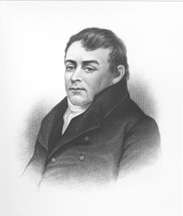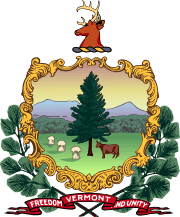William A. Palmer
| William Adams Palmer | |
|---|---|
 | |
| 13th Governor of Vermont | |
|
In office October 18, 1831 – November 2, 1835 | |
| Lieutenant | Lebbeus Egerton |
| Preceded by | Samuel C. Crafts |
| Succeeded by | Silas H. Jennison |
| United States Senator from Vermont | |
|
In office October 20, 1818 – March 3, 1825 | |
| Preceded by | James Fisk |
| Succeeded by | Dudley Chase |
| Member of the Vermont House of Representatives | |
|
In office 1811-1812 | |
| Personal details | |
| Born |
September 12, 1781 Hebron, Connecticut |
| Died |
December 3, 1860 (aged 79) Danville, Vermont |
| Political party | Democratic-Republican, National Republican, Anti-Masonic |
| Spouse(s) | Sarah Chandler Blanchard |
| Profession | Lawyer / Judge / Politician |
William Adams Palmer (September 12, 1781 – December 3, 1860) was an American politician, a lawyer, an Anti-Mason, thirteenth Governor of Vermont, and a US Senator from Vermont.
Biography
Palmer was born in Hebron, Connecticut. He was a descendant of Walter Palmer, part-founder of Charlestown, Massachusetts, and New London, Connecticut.[1] During childhood, he lost part of one hand in an accident when he slipped and fell on ice while carrying an axe. He completed his elementary education in Hebron. He studied law in Hebron with John Thompson Peters, later a Justice of the Connecticut Supreme Court, and then with Daniel Buck in Chelsea, Vermont. Palmer was admitted to the bar in 1805 and practiced in Brownington, Derby, and St. Johnsbury before settling in Danville. He married Sarah Chandler Blanchard of Danville in 1813, and the couple had seven children, five of whom survived to adulthood.[2] In 1817 Palmer areceived the honorary degree of master of arts from the University of Vermont.
Career
Palmer was elected Probate Judge for Caledonia County from 1807 to 1808, and from 1811 to 1817. He was clerk of the county court from 1807 to 1815, and a member of the Vermont House of Representatives from 1811 to 1812 and again in 1818. He was a judge of the Vermont Supreme Court from 1816 to 1818.[3]
In 1818, Palmer was elected to the United States Senate to fill the vacancy caused by the resignation of James Fisk; was re-elected and served from October 20, 1818 until March 3, 1825; first as a Democratic-Republican and from 1823 as a National Republican. He then returned to the state House of Representatives and to the position of judge.[4] He was also a delegate to the Vermont State Constitutional conventions in 1828, 1836, and 1850.
Palmer organized the first convention of Vermont's Anti-Masonic Party in Montpelier in 1829. He was elected Governor of Vermont in 1831 on the Anti-Masonic ticket and stayed in office until 1835. He proposed the 1833 law that any person administering a secret oath in any organization such as the Masons would be fined, and advocated the 1834 law to suspend the charter of Vermont's Grand Lodge.[5] During his tenure, imprisonment of females for debt was abolished, fourteen new schools were established, seven new banks were chartered, and legislation was enacted to expand the railway system. [6]
Palmer retired to his farm, but continued to be politically active and was a member of the Vermont State Senate from 1836 to 1837. He remained actively farming until shortly before his death.
Death
Palmer died on December 3, 1860 in Danville, and is interred in Danville Green Cemetery.[7]
References
- ↑ Brown, John Howard. The Twentieth Century Biographical Dictionary of Notable Americans. The Biographical Society, 1904.
- ↑ "William A. Palmer". Find A Grave. Retrieved 31 October 2012.
- ↑ "William A. Palmer". Biographical Directory of the United States Congress. Retrieved 31 October 2012.
- ↑ "William A. Palmer". National Governors Association. Retrieved 31 October 2012.
- ↑ "William A. Palmer". Find A Grave. Retrieved 31 October 2012.
- ↑ "William A. Palmer". National Governors Association. Retrieved 31 October 2012.
- ↑ "William A. Palmer". The Political Graveyard. Retrieved 31 October 2012.
External links
| Wikimedia Commons has media related to William A. Palmer. |
- Vermont State Archives
- Biographical Directory of the United States Congress
- National Governors Association
- The Political Graveyard
- Find A Grave
| United States Senate | ||
|---|---|---|
| Preceded by James Fisk |
U.S. Senator (Class 3) from Vermont 1818–1825 Served alongside: Isaac Tichenor, Horatio Seymour |
Succeeded by Dudley Chase |
| Political offices | ||
| Preceded by Samuel C. Crafts |
Governor of Vermont 1831-1835 |
Succeeded by Silas H. Jennison |

